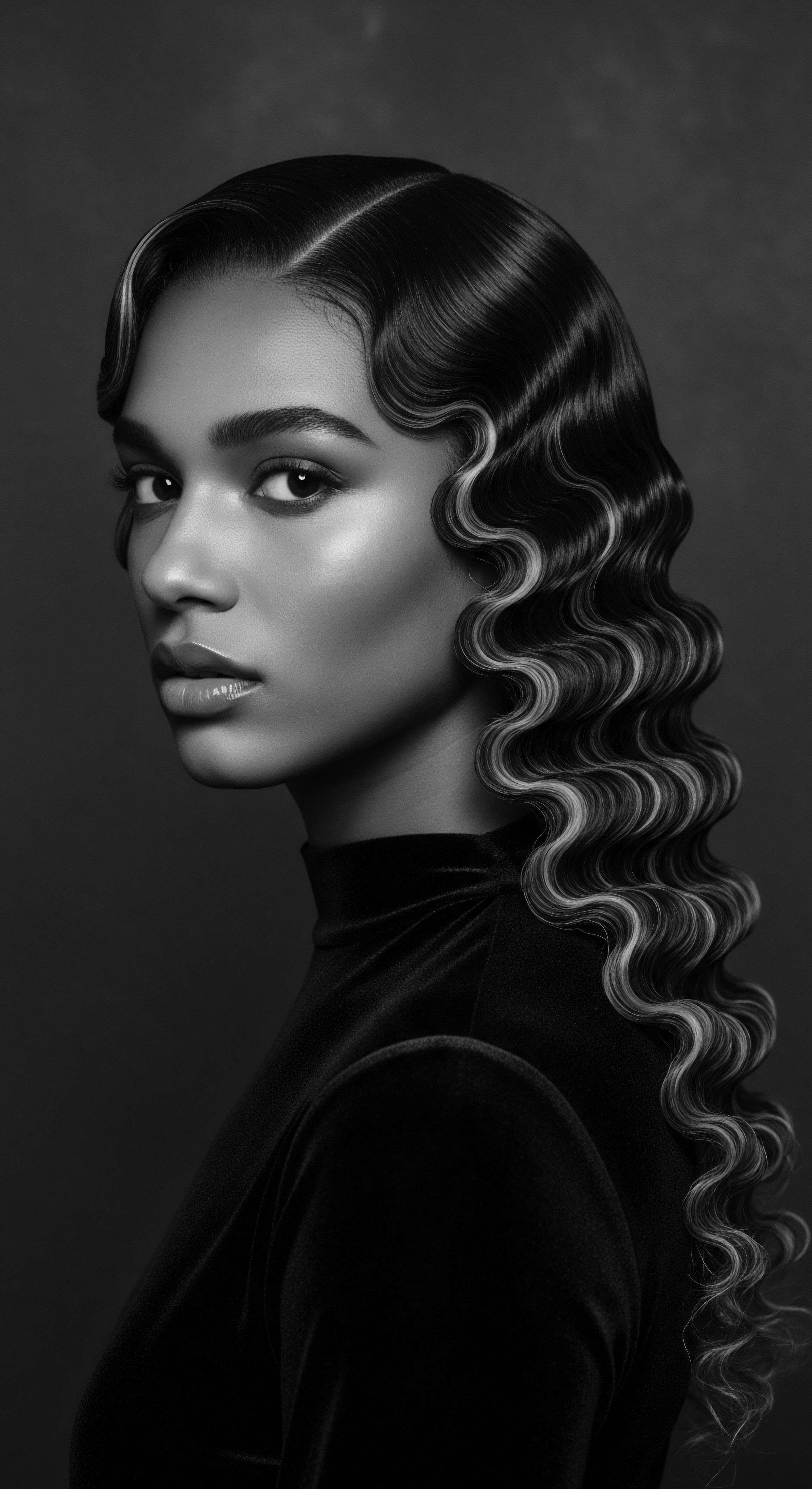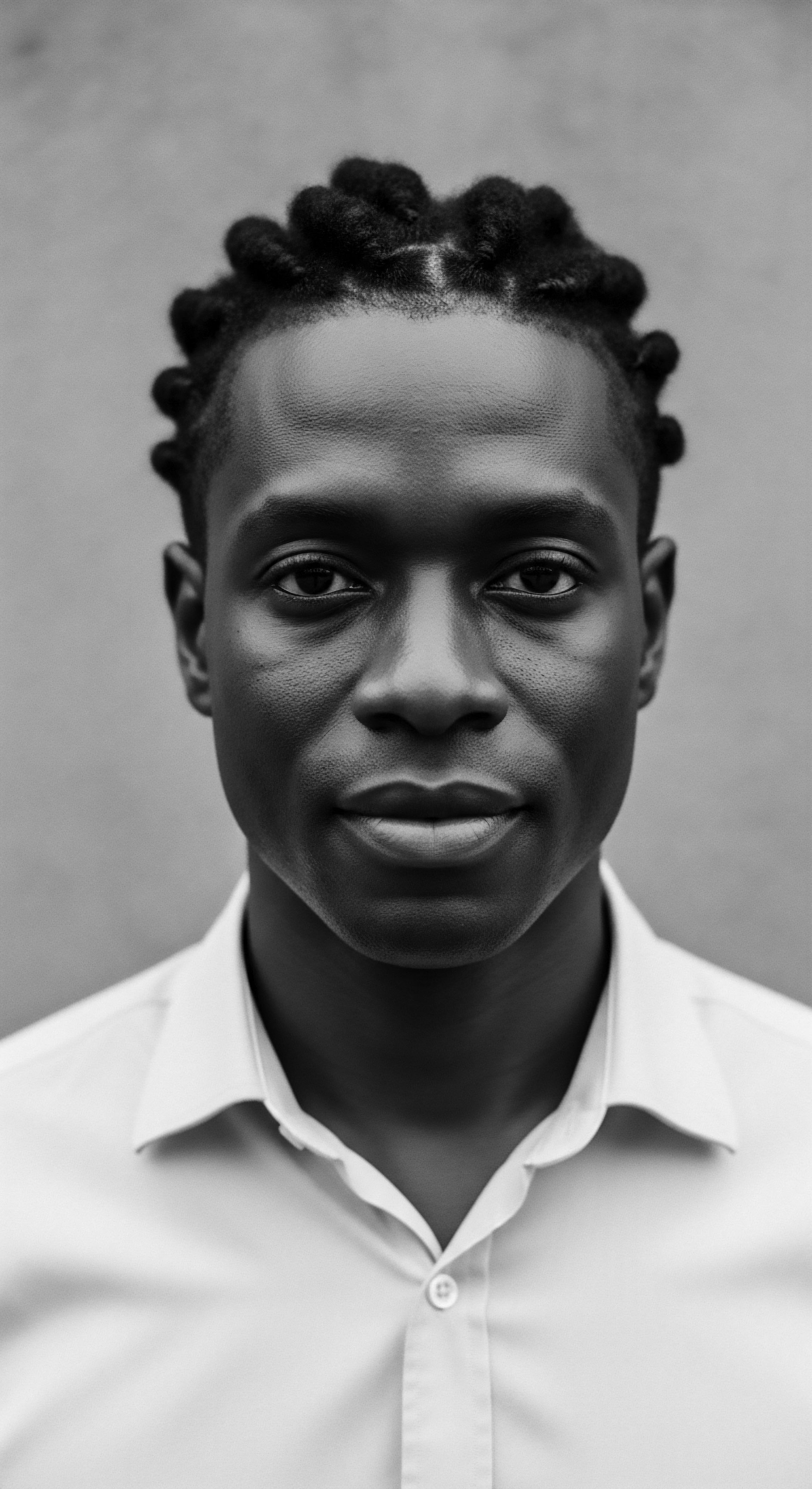
Fundamentals
The concept of Traditional Butters, as understood within Roothea’s living library, reaches far beyond a simple cosmetic ingredient. It represents a profound, ancestral wisdom embedded in the very earth, a testament to humanity’s enduring connection with the natural world for sustenance and adornment. At its simplest, the Definition of Traditional Butters refers to a category of natural, unrefined plant-derived fats, extracted from the seeds, nuts, or fruits of specific trees and plants. These botanical emollients have served as foundational elements in communal well-being and personal care rituals for millennia, particularly across communities with rich traditions of textured hair care.
Their Meaning extends to their elemental biology. These butters are rich matrices of fatty acids, vitamins, and unsaponifiable lipids, which are compounds that do not convert into soap when exposed to alkali. This unique composition grants them exceptional moisturizing, protective, and restorative qualities.
Unlike their highly processed counterparts found in modern formulations, Traditional Butters retain the full spectrum of their natural goodness, carrying the subtle scents of their origin and the inherent vitality of the plants from which they spring. The unrefined state preserves their therapeutic properties, making them potent agents of care.

Origins and Ancestral Applications
The ancestral lineage of Traditional Butters traces back to the heart of ancient civilizations, where their procurement and preparation were often sacred communal rites. Across West Africa, for instance, the Shea Tree (Vitellaria paradoxa) yielded its precious butter, a substance so central to life it was often referred to as ‘women’s gold.’ Generations of women have meticulously harvested, crushed, roasted, and kneaded shea nuts to extract the butter, a process passed down through oral tradition and practical demonstration. This deep-rooted practice is not merely about production; it signifies a continuum of ancestral knowledge, a shared heritage.
Similarly, in the Amazonian rainforests, the Murumuru Palm (Astrocaryum murumuru) provided a butter revered for its ability to soften and shield. Indigenous communities understood the unique properties of these natural fats, recognizing their ability to seal moisture within the hair shaft, protect against environmental aggressors, and impart a lustrous sheen. The daily application of these butters was often integrated into grooming rituals, serving as both a practical measure for hair health and a symbolic gesture of self-care and communal bonding.
Traditional Butters are elemental expressions of Earth’s bounty, their heritage deeply intertwined with the ancient wisdom of communities who learned to coax nourishment from the land for hair and skin.

The Protective Veil ❉ Early Hair Care
For textured hair, which by its very structure tends to be more prone to dryness due to the winding path of its cuticle layers, Traditional Butters served as an indispensable protective veil. The natural oils and fats within these butters formed a substantive barrier, mitigating moisture loss and shielding delicate strands from the harsh sun, arid winds, and abrasive elements. This understanding of their occlusive properties, while not articulated in modern scientific terms by ancient practitioners, was intuitively grasped through centuries of lived experience and observation.
- Shea Butter ❉ Revered across the Sahel region for its deeply moisturizing and protective qualities, often used to soften hair and skin, and to protect against the dry climate.
- Cocoa Butter ❉ Sourced from the cacao bean, this butter was valued in Mesoamerican civilizations for its rich emollient properties, contributing to hair’s suppleness and sheen.
- Mango Butter ❉ Derived from the seed of the mango fruit, its use in South Asia and other tropical regions provided a lighter yet effective conditioning agent for various hair types.
The simplicity of their application, often just warmed in the palm and gently massaged into the scalp and strands, belies the profound efficacy of these natural remedies. They were not merely products; they were integral components of a holistic approach to well-being, where the health of the hair was seen as a reflection of overall vitality and a connection to one’s lineage.

Intermediate
Moving beyond the foundational understanding, the Interpretation of Traditional Butters deepens when considering their specific roles within the rich tapestry of textured hair heritage. These butters are not interchangeable; each possesses a unique profile of fatty acids and unsaponifiable matter, lending distinct properties that were intuitively understood and strategically utilized by ancestral communities. This nuanced appreciation forms the bedrock of their enduring significance.

Biochemical Signatures and Hair Affinity
The efficacy of Traditional Butters for textured hair stems from their unique biochemical signatures. For example, Shea Butter is characterized by a significant proportion of oleic and stearic acids, alongside a remarkable unsaponifiable fraction (often 5-17%) that includes triterpenes, tocopherols, phenols, and sterols. These unsaponifiables are particularly beneficial, acting as natural anti-inflammatory agents and antioxidants, offering protective benefits beyond simple moisturization. The Clarification of their value rests in this synergy between fatty acids and minor components.
For coily and kinky hair patterns, which possess an elliptical cross-section and numerous twists and turns along the hair shaft, the natural sebum produced by the scalp struggles to travel down the entire length of the strand. This inherent structural characteristic often results in chronic dryness. Traditional Butters, with their dense yet pliable consistency, effectively mimic and supplement the scalp’s natural oils, providing external lubrication and a robust moisture seal. This practical application demonstrates a deep ancestral understanding of hair physiology, long before modern scientific instruments could confirm such insights.

The Tender Thread ❉ Community and Ritual
The Elucidation of Traditional Butters’ meaning extends beyond their chemical composition to their profound cultural and communal resonance. The process of making and applying these butters was rarely a solitary act. In many West African societies, the production of shea butter, for instance, involved collective effort, often led by elder women who imparted not only the technical skills but also the associated songs, stories, and spiritual reverence for the tree and its bounty. This shared labor fostered community bonds and reinforced cultural identity.
The preparation and application of Traditional Butters were often communal rites, weaving threads of ancestral knowledge, shared stories, and cultural identity into the very fiber of hair care.
Hair grooming, often a leisurely activity performed in communal settings, served as a conduit for intergenerational knowledge transfer. Children learned about their hair type, the properties of different plants, and the importance of consistent care through observation and participation. The tactile experience of massaging butter into a loved one’s scalp, the shared laughter, and the quiet moments of connection created a living library of heritage. This was where the Connotation of hair care as a sacred, identity-affirming practice truly blossomed.
| Traditional Butter Shea Butter (Vitellaria paradoxa) |
| Ancestral Hair Care Practice Applied to hair and scalp for softness, moisture retention, and protection from sun/wind; often used for styling and braid lubrication. |
| Modern Scientific Understanding (Connecting to Heritage) Rich in oleic and stearic acids, forming an occlusive barrier to reduce transepidermal water loss. High unsaponifiable content (triterpenes, tocopherols) provides antioxidant and anti-inflammatory properties, supporting scalp health. |
| Traditional Butter Cocoa Butter (Theobroma cacao) |
| Ancestral Hair Care Practice Used to add shine, prevent breakage, and condition hair, particularly in regions where cacao was cultivated. |
| Modern Scientific Understanding (Connecting to Heritage) Contains high levels of saturated fatty acids (stearic, palmitic), contributing to its solid texture and strong emollient capabilities, sealing cuticles and adding gloss. |
| Traditional Butter Murumuru Butter (Astrocaryum murumuru) |
| Ancestral Hair Care Practice Utilized in Amazonian communities for its ability to soften hair, restore elasticity, and protect against environmental damage. |
| Modern Scientific Understanding (Connecting to Heritage) Abundant in lauric, myristic, and oleic acids, offering deep penetration and moisture binding properties, particularly beneficial for brittle or damaged textured hair. |
| Traditional Butter The enduring wisdom of ancestral hair care, recognizing the intrinsic value of these butters, finds affirmation in contemporary scientific insights into their unique molecular structures and benefits. |

Cultural Significance and Adornment
Beyond practical utility, Traditional Butters played a vital role in hair adornment and cultural expression. Elaborate hairstyles, often signifying social status, age, or marital standing, required emollients that could hold intricate designs while keeping the hair healthy. Butters provided the necessary pliability and hold, allowing for the creation of cornrows, braids, and twists that were not only protective styles but also profound artistic statements. The very act of styling, often involving the application of these butters, became a performance of identity, a visual language spoken through hair.
The Import of these butters also lay in their ability to preserve hair over long periods, especially during times of transition or ceremony. They allowed for the creation of styles that could last for days or weeks, protecting the hair from manipulation and environmental stress. This foresight in hair care, driven by the unique properties of Traditional Butters, speaks to a deep, intuitive understanding of textured hair’s specific needs for minimal handling and maximum protection.

Academic
The academic Definition of Traditional Butters transcends anecdotal observation, grounding itself in ethnobotanical studies, biochemical analysis, and socio-anthropological research. It delineates these substances as complex lipidic matrices derived from specific plant sources, traditionally processed without chemical solvents or extensive refining, and historically employed by indigenous and diasporic communities for their therapeutic, protective, and cosmetic properties, particularly for textured hair. This scholarly perspective reveals a sophisticated understanding of natural resources, often passed down through generations, predating modern scientific nomenclature.

Biogeography and Phytochemistry ❉ Echoes from the Source
The geographical distribution of specific Traditional Butter-yielding plants often correlates with the prevalence of textured hair types in those regions, suggesting an adaptive co-evolution of natural resources and human needs. The shea tree, native to the semi-arid savannah belt of West and Central Africa, thrives in conditions that also shape the hair characteristics of the indigenous populations. Its fruit yields a butter uniquely suited to mitigating the effects of harsh sun and dry air on highly coiled hair.
The Delineation of its chemical constituents reveals a high proportion of saturated and monounsaturated fatty acids, alongside a significant unsaponifiable fraction that includes potent antioxidants and anti-inflammatory compounds. This particular composition provides both occlusive and restorative benefits, crucial for maintaining moisture balance and structural integrity in hair prone to dryness and breakage.
Consider the case of shea butter’s economic and social significance in West Africa, a profound example of its heritage connection. A study by the Global Shea Alliance (2016) indicated that shea is a primary source of income for approximately 16 million women in rural West Africa, representing a multi-billion dollar global industry. This economic reality is not a modern construct; it builds upon centuries of traditional harvesting and processing methods, where the collective effort of women transformed shea nuts into a vital commodity for local economies and personal care.
The butter’s journey from a localized, community-driven resource to a global ingredient underscores its enduring Significance, demonstrating how ancestral practices have shaped contemporary markets while maintaining a deep cultural resonance. (Global Shea Alliance, 2016)

The Unbound Helix ❉ Structural Protection and Ancestral Ingenuity
From an academic standpoint, the Specification of Traditional Butters’ efficacy for textured hair lies in their ability to interact with the unique morphology of the hair shaft. Textured hair, characterized by its elliptical cross-section and numerous twists, presents challenges for the uniform distribution of sebum and increased susceptibility to mechanical stress. The higher concentration of hydrophobic lipids in butters, compared to lighter oils, allows them to form a more substantive film on the hair surface. This film effectively reduces the rate of water evaporation from the cortex, a phenomenon critical for maintaining hair elasticity and preventing brittleness.
Traditional Butters offer a unique protective mechanism for textured hair, their historical application validated by modern science’s understanding of lipid interactions with the hair shaft’s intricate architecture.
The ancestral ingenuity in utilizing these butters was not merely intuitive; it represented an empirical understanding of hair biology developed through generations of observation and adaptation. For example, the traditional practice of “greasing” the scalp and hair with butters before braiding or styling served to reduce friction during manipulation, a known contributor to breakage in textured hair. This preventive measure, now understood through principles of tribology (the science of friction, wear, and lubrication), was a fundamental aspect of ancestral hair care.
- Fatty Acid Profiles ❉ The varying ratios of saturated, monounsaturated, and polyunsaturated fatty acids in different butters determine their melting points, penetration capabilities, and occlusive properties, influencing their suitability for diverse hair needs.
- Unsaponifiable Matter ❉ These non-fatty acid components, often rich in antioxidants like Vitamin E and triterpenes, contribute anti-inflammatory and regenerative properties, benefiting scalp health and hair follicle vitality.
- Rheological Properties ❉ The semi-solid consistency of butters at room temperature provides a desirable viscosity for application, allowing for controlled distribution and sustained adhesion to the hair shaft.

Sociocultural Dimensions and Identity ❉ The Unbound Helix
The academic Explication of Traditional Butters extends into the sociocultural realm, examining their role in the construction of identity, community resilience, and resistance against colonial beauty standards. During periods of cultural suppression, particularly within the African diaspora, the continued use of traditional hair care practices, including the application of ancestral butters, became an act of defiance and a silent affirmation of heritage. Hair, adorned with these natural emollients, served as a visible marker of identity, a connection to an ancestral past that colonial powers sought to erase.
This perspective reveals that Traditional Butters were not merely functional; they were symbolic anchors. They represented continuity, a link to the knowledge systems of forebears, and a rejection of imposed narratives that devalued textured hair. The communal rituals surrounding their preparation and application fostered solidarity and became spaces for the transmission of cultural narratives, songs, and values.
This deep historical context elevates the Purport of Traditional Butters beyond their physical properties, recognizing them as vehicles of cultural memory and instruments of self-determination. The enduring presence of these butters in contemporary textured hair care speaks to a powerful legacy of self-acceptance and pride, demonstrating a continuous lineage of care and cultural preservation.

Reflection on the Heritage of Traditional Butters
As we draw near the close of this exploration, the profound Essence of Traditional Butters truly comes into focus, not merely as substances, but as living conduits of ancestral wisdom and enduring heritage. They are more than just emollients for textured hair; they are echoes of ancient hands, whispers of communal gatherings, and tangible links to a past where connection to the Earth and to one another was paramount. The journey from elemental biology to their role in shaping identity is a testament to their deep-seated relevance within the Soul of a Strand.
The narrative of Traditional Butters is a continuous flow, a river carrying the sediment of millennia, enriching the soil of present-day hair care. Each application today, whether in a bustling city salon or a quiet home, carries with it the memory of women processing shea nuts under the African sun, or Amazonian communities honoring the bounty of the rainforest. This lineage is not static; it breathes, adapts, and continues to shape the understanding of what true hair care means for textured strands across the globe. It is a heritage of resilience, of beauty born from the Earth, and of knowledge passed down through the generations, affirming the inherent worth and unique needs of every coil, curl, and kink.
The future of textured hair care, in many ways, looks to its past. The renewed appreciation for Traditional Butters signifies a collective turning towards authenticity, sustainability, and practices that honor both the body and the planet. It is a quiet revolution, driven by a desire to reconnect with ancestral ways, to listen to the wisdom of the elders, and to find solutions that are not only effective but also deeply respectful of cultural origins. In this continuous cycle of learning and rediscovery, Traditional Butters stand as enduring symbols of the unbound helix – hair that tells a story, that holds memory, and that continues to grow, rooted in its profound and beautiful heritage.

References
- Akihisa, T. Kojima, N. Kikuchi, T. Yasukawa, K. & Takido, M. (1996). Anti-inflammatory and chemopreventive effects of triterpene cinnamates and acetates from shea fat. Journal of Oleo Science, 45(12), 1033-1040.
- Fleischhauer, S. (2009). The Cultural and Economic Significance of Shea Butter in West Africa. German Agency for Technical Cooperation (GTZ).
- Global Shea Alliance. (2016). Annual Report 2016 ❉ Empowering Women, Protecting the Environment. Global Shea Alliance.
- Hall, J. B. & Tomlinson, P. B. (1999). The Biogeography of Shea (Vitellaria paradoxa C.F. Gaertn.) in West Africa. Economic Botany, 53(1), 1-13.
- Kapseu, C. & Tchiegang, C. (2007). Processing and Valorization of Shea Nut Products in Africa. African Centre for Technology Studies (ACTS) Press.
- Ofori, D. A. Tchoundjeu, Z. & Jamnadass, R. (2009). Domestication of Vitellaria paradoxa ❉ Opportunities for enhancing livelihoods in the shea parklands of West Africa. Forest, Trees and Livelihoods, 19(2), 101-114.
- Osman, M. A. (2011). The potential of shea butter (Vitellaria paradoxa) in food and cosmetics applications. African Journal of Biotechnology, 10(27), 5323-5332.
- Parry, J. W. (1969). The Story of Shea Butter. Chemical Publishing Co.
- Verma, R. S. Padalia, R. C. Chauhan, A. & Thul, S. T. (2014). Essential oil composition and antimicrobial activity of Astrocaryum murumuru seed oil. Journal of Essential Oil Research, 26(6), 460-464.
